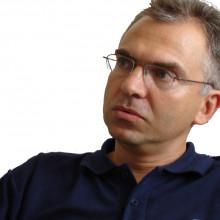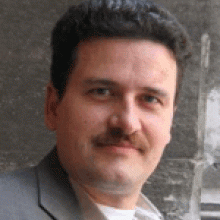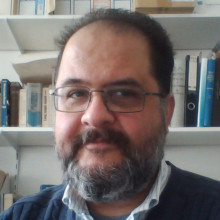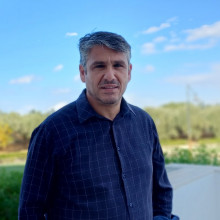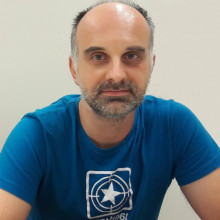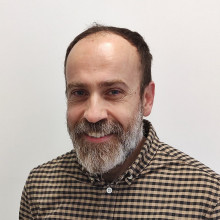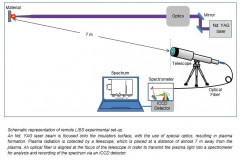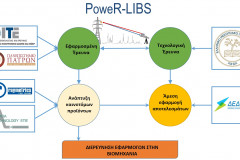Position Description
Development and characterization of semiconducting nano- and/or microcrystals, with emphasis on inorganic halogen perovskites. The aim is to apply these materials to gas and/or breath detection and energy storage.
For the full announcement, follow the link "Related Documents"
Required Qualifications
- Bachelor's degree (B.Sc.) from a School of Sciences or a related school
- Postgraduate Diploma in a School of Sciences or a related school
- Experimental laboratory experience in materials development and characterization techniques
- Relevant publications
Application Procedure
Interested candidates who meet the aforementioned requirements are kindly asked to submit their applications with cc to the Scientific Responsible, Dr Emmanuel Stratakis (stratak@iesl.forth.gr).
In order to be considered, the application must include:
- Application Form (Form Greek or Form English to the left)
- Detailed curriculum vitae (CV) of the candidate
- Scanned Copies of academic titles
- Certificate for enrollment in a PhD program
Appointment Duration
12 monthsPosition Description
Development and optimization of a structured illumination system
For the full announcement, follow the link "Related Documents"
Required Qualifications
- BSc degree in Physics (10%)
- Msc in material science
- Working experience in optical imaging technologies
- Working experience in developing optical systems
- Knowledge of simulation setups in Matlab and Mathematica
- English language
Application Procedure
Interested candidates who meet the aforementioned requirements are kindly asked to submit their applications to the address (hr@iesl.forth.gr), with cc to Dr Giannis Zacharakis (zahari@iesl.forth.gr).
In order to be considered, the application must include:
- Application Form (Form Greek or Form English to the left)
- Brief CV
- Scanned copies of academic titles
- Certificate of enrollment in a PhD program
Appointment Duration
6 monthsPosition Description
Διέγερση μοριακών δεσμών με λέιζερ στο υπέρυθρο, και ανίχνευση της πόλωσης των θραυσμάτων της φωτοδιάσπασης. Επιτάχυνση ιόντων πολωμένου υδρογόνου με ισχυρούς παλμούς λέιζερ.
Για το πλήρες κείμενο της πρόσκλησης ακολουθήστε τον σύνδεσμο 'Related Documents'
Related Project
NUPOL -Required Qualifications
- Πτυχίο Σχολής Θετικών Επιστημών ή συναφούς σχολής [απαιτείται απλό φωτοαντίγραφο πτυχίου]
- Εγγεγραμμένος/η σε πρόγραμμα Master/μεταπτυχιακό πρόγραμμα Θετικών επιστημών ή συναφούς σχολής ημεδαπής [απαιτείται πρόσφατη (<6 μηνών) βεβαίωση]
- Ερευνητική Εμπειρία σε nanosecond laser [όπως προκύπτει από το βιογραφικό ή άλλες πηγές]
- Ερευνητική εμπειρία σε Velocity Map Imaging ή ανάλογες τεχνικές [όπως προκύπτει από το βιογραφικό ή άλλες πηγές]
Application Procedure
Στο φάκελο υποβολής της πρότασης θα πρέπει να εμπεριέχονται τα ακόλουθα:
- Αίτηση (Form Greek στην αριστερή στήλη) με αναφορά στον κωδικό της θέσης και στο όνομα του προγράμματος
- Αναλυτικό Βιογραφικό Σημείωμα
- Ευκρινή φωτοαντίγραφα τίτλων σπουδών
- Πρόσφατη βεβαίωση σπουδών μεταπτυχιακού φοιτητή
ΥΠΟΒΟΛΗ ΠΡΟΤΑΣΕΩΝ
Οι ενδιαφερόμενοι καλούνται να υποβάλουν τις αιτήσεις τους και όλα τα απαραίτητα δικαιολογητικά, ηλεκτρονικά στη διεύθυνση hr@iesl.forth.gr με κοινοποίηση (cc): στον Δρ Π. Σαμαρτζή (sama@iesl.forth.gr). Οι αιτήσεις θα πρέπει να αποσταλούν με την ένδειξη: «Αίτηση στο πλαίσιο του προγράμματος NUPOL, της πρόσκλησης εκδήλωσης ενδιαφέροντος με Α.Π. … και κωδικό θέσης … » (όπως αυτός αναφέρεται στον Πίνακα του Παραρτήματος).

Appointment Duration
2 μήνεςFunding

Position Description
The candidate will participate in the R&D activities of FORTH-IESL in the context of PERCEIVE project and will work on Hyperspectral imaging data acquisition, processing, and data management related aspects. The researcher will be, however, involved in the overall research activities of PERCEIVE Project, aiming at improving the perception, preservation, curation, exhibition, understanding and access of coloured Cultural Heritage Collections and developing a reliable way to Study, Reconstruct, Render, Remap, Exhibit and Re-appropriate them. Role and Responsibilities Responsibly carrying out activities related to the PERCEIVE collaborative research project. Namely:
- Research into VIS/NIR hyperspectral imaging data processing.
- Instrumental setup, data acquisition, processing, analysis, and interpretation.
- Design of PERCEIVE data model and PERCEIVE data repository.
- Optimisation of data workflows in the entire data life cycle from capturing, processing, analyzing (including semantics), interlinking data to assure the quality of services.
- Dissemination of achievements in international journals and conferences.
For the full announcement, follow the link "Related Documents"
Required Qualifications
- PhD in Physics, Maths or Computer Sciences or in Engineering, with a focus on imaging, spectroscopy, optics, optical sensing
- Proven skills in Software development for spectral data processing
- Proven previous experience with handling and practical implementation of imaging / spectroscopic systems (e.g. detectors, light sources, data acquisition and control, data analysis)
- Fluent oral and written communication skills in English
- Experience with cultural heritage studies (object analysis, campaigns)
Desirable Qualifications
- Previous post-doctoral research experience
- Relevant scientific publications
- Innovative, autonomous, well-organised and result-oriented thinking; Ability and motivation to perform independent research
- Prompt to cooperate with interdisciplinary and international teams
- Previous work in RTD projects
Application Procedure
Interested candidates who meet the aforementioned requirements are kindly asked to submit their applications to the address (hr@iesl.forth.gr), with cc to the Scientific Responsible, Prof. S. Sotiropoulou (sophiaso@iesl.forth.gr).
In order to be considered, the application must include:
- Application Form (Form Greek or Form English to the left)
- Detailed curriculum vitae (CV) of the candidate
- Scanned Copies of academic titles
Appointment Duration
12 monthsThe main goal of PoweR-LIBS is to develop a novel diagnostic procedure for the rapid, remote, real-time evaluation of polymeric insulators high-voltage overhead power transmission lines.
The procedure relies on the LIBS technique (Laser-Induced Breakdown Spectroscopy) which enables surface analysis of composite insulators and correlation of the compositional results with the operational capacity of the insulators. In the context of the proposed research an integrated unit will be designed and constructed, based on advanced remote sensing technology, which will enable field deployment of Remote LIBS analysis (R-LIBS) for probing insulators in situ with no need to remove them from the power lines.
In parallel, computational tools will be employed, based on machine- and deep-learning algorithms and neural networks for exploiting the total information in LIBS spectra for achieving reliable classification of the insulators with respect to their operational characteristics. The overall diagnostic procedure includes the use of an Unmanned Aerial Vehicle (UAV) for carrying out aerial inspection of the insulators for identifying on their surface the areas where R-LIBS analysis is to be performed.
The proposed research is expected to produce innovation at several ends. In the research organizations (FORTH, HMU, U of Patras) through the development of know-how on the application of advanced optical diagnostic techniques and computational tools. In the companies, in relation to the design and production of innovative diagnostic systems (RAYMETRICS, LAMDA) and their introduction as new methodologies for power line insulator diagnostics (HEDNO).
Object and Objectives of the "PoweR-LIBS" Project
Development of an innovative diagnostic procedure based on the technique of laser plasma spectroscopy (LIBS – Laser-Induced Breakdown Spectroscopy) that will allow the rapid, remote and real-time evaluation of the physical and functional state of synthetic insulators, type SIR (Silicone Rubber), which they are widely used in outdoor high voltage power transmission lines.
a) design and construction of an integrated Remote–LIBS (R–LIBS) system, for use in the field, based on advanced remote sensing technology for the characterization of synthetic insulators without requiring their removal from transmission lines.
b) use of advanced machine learning algorithms and neural networks in order to develop powerful tools for the processing and evaluation of LIBS spectral data in order to achieve a reliable categorization of insulators in terms of their physical, functional characteristics,
c) use of a remote-controlled unmanned aerial vehicle (UAV/drone) in order to safely approach the insulators and visually inspect them for the more precise determination, on the surface of each insulator, of the appropriate analysis area with the R-LIBS system (and additionally for the investigation of the collection of spectral information by the plasma).
Principal Investigator
Scientific Staff
Technical Staff
Research Associates

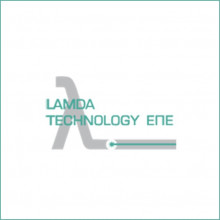
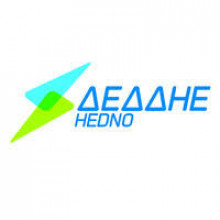
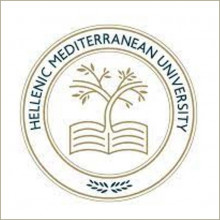
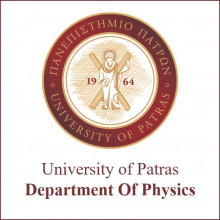
Funding

Position Description
Quantum Key Distribution and Physical Unclonable Functions.
In the framework of HellasQCI, the candidate is expected to work in aspects of quantum cryptography, focusing mainly on quantum key distribution (QKD) protocols, and physical unclonable functions. The candidate will have the opportunity to interact with QKD devices, to participate in the implementation of the local HellasQCI network, as well as in the demonstration of certain use cases of QKD. Finally, he/she will be involved in training activities.
For the full announcement, follow the link "Related Documents"
Required Qualifications
- Undergraduate degree in Physics, Electrical Engineering or similar
- Background in Quantum Optics or Quantum Photonics
- Recommendation Letters
- Programming skills (preferably Python, or Matlab or C++)
Desirable Qualifications
Very good knowledge of English
Application Procedure
Interested candidates who meet the aforementioned requirements are kindly asked to submit their applications to the address (hr@iesl.forth.gr), with cc to Dr George Nikolopoulos (nikolg@iesl.forth.gr).
In order to be considered, the application must include:
- Application Form (Form Greek or Form English to the left)
- Detailed curriculum vitae (CV) of the candidate
- Scanned Copies of academic titles
- Certificate for enrollment in a master’s program


